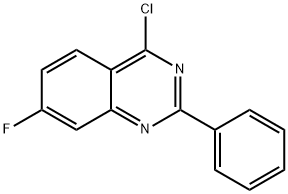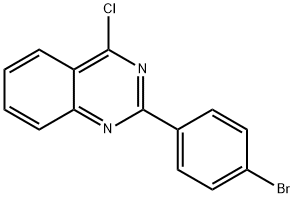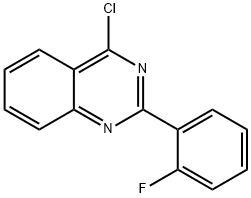4-CHLORO-2-PHENYLQUINAZOLINE
Synonym(s):AM-ex-OL;NSC 400965
- CAS NO.:6484-25-9
- Empirical Formula: C14H9ClN2
- Molecular Weight: 240.69
- MDL number: MFCD00006713
- EINECS: 229-346-2
- SAFETY DATA SHEET (SDS)
- Update Date: 2023-04-23 13:52:06

What is 4-CHLORO-2-PHENYLQUINAZOLINE?
Chemical properties
slightly yellow to yellow crystalline powder
The Uses of 4-CHLORO-2-PHENYLQUINAZOLINE
4-Chloro-2-phenylquinazoline can be involved in the synthesis of biologically active molecules including: Nitrotriazole amines or nitroimidazole amines for use as antitrypanosomal activity and mammalian cytotoxicity.
The Uses of 4-CHLORO-2-PHENYLQUINAZOLINE
Reactant involved in the synthesis of biologically active molecules including:
- Nitrotriazole amines or nitroimidazole amines for use as antitrypanosomal activity and mammalian cytotoxicity
- Quinazoline-containing piperazinylpyrimidine derivatives with antitumor activity
- Quinazoline substituted cyclopentane as HCV NS3/4A protease inhibitors
- Quinazolines with antibacterial and antitumor activity
- Aurora inhibitor MK-0457
Reactant involved in Suzuki-Miyaura cross-coupling and catalyst-free / base-free water promoted nucleophilic aromatic substitution
What are the applications of Application
4-Chloro-2-phenylquinazoline is a reactant involved in Suzuki-Miyaura cross-coupling
Synthesis Reference(s)
Journal of the American Chemical Society, 68, p. 1299, 1946 DOI: 10.1021/ja01211a055
Properties of 4-CHLORO-2-PHENYLQUINAZOLINE
| Melting point: | 124-126 °C(lit.) |
| Boiling point: | 383.11°C (rough estimate) |
| Density | 1.285 |
| refractive index | 1.5749 (estimate) |
| storage temp. | under inert gas (nitrogen or Argon) at 2–8 °C |
| pka | 0.67±0.30(Predicted) |
| form | Crystalline Powder |
| color | Slightly yellow to yellow |
| CAS DataBase Reference | 6484-25-9(CAS DataBase Reference) |
Safety information for 4-CHLORO-2-PHENYLQUINAZOLINE
| Signal word | Warning |
| Pictogram(s) |
 Exclamation Mark Irritant GHS07 |
| GHS Hazard Statements |
H315:Skin corrosion/irritation H319:Serious eye damage/eye irritation H335:Specific target organ toxicity, single exposure;Respiratory tract irritation |
| Precautionary Statement Codes |
P261:Avoid breathing dust/fume/gas/mist/vapours/spray. P305+P351+P338:IF IN EYES: Rinse cautiously with water for several minutes. Remove contact lenses, if present and easy to do. Continuerinsing. |
Computed Descriptors for 4-CHLORO-2-PHENYLQUINAZOLINE
| InChIKey | OBHKONRNYCDRKM-UHFFFAOYSA-N |
New Products
4-AMINO-TETRAHYDRO-PYRAN-4-CARBOXYLIC ACID HCL 4-(Dimethylamino)tetrahydro-2H-pyran-4-carbonitrile 4-Aminotetrahydropyran-4-carbonitrile Hydrochloride (R)-3-Aminobutanenitrile Hydrochloride 3-((Dimethylamino)methyl)-5-methylhexan-2-one oxalate 1,4-Dioxa-8-azaspiro[4.5]decane 5-Bromo-2-nitropyridine Nimesulide BP Aceclofenac IP/BP/EP Diclofenac Sodium IP/BP/EP/USP Mefenamic Acid IP/BP/EP/USP Ornidazole IP Diclofenac Potassium THOMAIND PAPER PH 2.0 TO 4.5 1 BOX BUFFER CAPSULE PH 9.2 - 10 CAP SODIUM CHLORIDE 0.1N CVS ALLOXAN MONOHYDRATE 98% PLATINUM 0.5% ON 3 MM ALUMINA PELLETS (TYPE 73) LITHIUM AAS SOLUTION 2-Bromo-1-(bromomethyl)-3-chloro-5-nitrobenzene 2-Bromo-3-nitroaniline N-(3-Hydroxypropyl)-N-methylacetamide 3-Bromo-6-chloropyridazine 4-ethyl-3-nitrobenzoic acidRelated products of tetrahydrofuran








You may like
-
 1-Methyl-6-oxo-1,6-dihydropyridazine-3-carbonitrile 98%View Details
1-Methyl-6-oxo-1,6-dihydropyridazine-3-carbonitrile 98%View Details
99903-60-3 -
 88491-46-7 98%View Details
88491-46-7 98%View Details
88491-46-7 -
 1823368-42-8 98%View Details
1823368-42-8 98%View Details
1823368-42-8 -
 2-(3-(tert-butyl)phenoxy)-2-methylpropanoic acid 1307449-08-6 98%View Details
2-(3-(tert-butyl)phenoxy)-2-methylpropanoic acid 1307449-08-6 98%View Details
1307449-08-6 -
 Ethyl 3-(furan-2-yl)-3-hydroxypropanoate 25408-95-1 98%View Details
Ethyl 3-(furan-2-yl)-3-hydroxypropanoate 25408-95-1 98%View Details
25408-95-1 -
 2-Chloro-5-fluoro-1-methoxy-3-methylbenzene 98%View Details
2-Chloro-5-fluoro-1-methoxy-3-methylbenzene 98%View Details
1805639-70-6 -
 1784294-80-9 98%View Details
1784294-80-9 98%View Details
1784294-80-9 -
 Lithium ClavulanateView Details
Lithium ClavulanateView Details
61177-44-4
Statement: All products displayed on this website are only used for non medical purposes such as industrial applications or scientific research, and cannot be used for clinical diagnosis or treatment of humans or animals. They are not medicinal or edible.